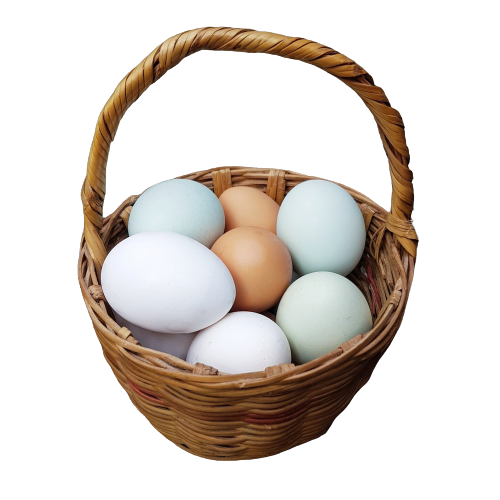Before you start a flock or decide to grow your flock, there are five major things to consider first. Taking these five things into consideration will ensure that your chickens are healthy and that your ladies produce the most eggs or your meat birds grow to their biggest potential.
Selecting the right breed of chicken
Do you want chickens that lay lots of eggs, chickens that look cool, or meat birds? Once you have decided what kind of chickens you want, then it’s time to pick the breed. This list of chickens for egg-laying, cool birds, and meat birds are excellent choices for Utah.
Egg Layers
These birds are great birds for laying eggs in the cold and hot Utah climate.
Australorp, Silkie, Plymouth Rock, Cochin, Rhode Island Red, Welsummer, Wyandotte, Buff Orpington
Cool Birds
These birds may not be the best egg layers or the best in the winter, but they will add a little extra to your flock.
Ameraucana, Cochin, Silkie, Golden Sebright, Silver Sebright, Silver Laced Polish, White Crested Black Polish
Meat Birds
These birds have a significant growth rate and will provide you with meat in no time.
White cornish cross, Red Ranger, Turken, Bresse, Barred Plymouth Rock
Decide how many chickens you will need

This all depends on how many eggs you want a week. Chickens like to be in flocks so try and have at least three chickens. Hens on average will lay about two eggs every three days on average. But you will want to look at each breed you chose and decide how many you will need.
For example, let’s say I want to have 12 eggs a week, I could have one Rhode Island Red(laying around six eggs a week), one Wyandotte(laying around four eggs a week, and one Welsummer(laying around four eggs a week) that would give me about 14 eggs a week.
Setup for your new chicks
Before you pick up your chicks, make them a brooder. You can use anything you want as a brood. Just make sure it’s 24 inches tall and has one square foot per chick.
Things you will need to put into your brooder. Wood shavings for bedding one to two inches of shavings. A waterer and a feeder at the end of the brooder. In their water, you will want to add electrolytes to keep them hydrated and probiotics to help build healthy digestive function. On the other end put a heat lamp, placing heat lamp 12-36 inches from the bottom.
At six weeks old, it’s time to transfer your chicks into the coop.
Chicken coop and run setup
These things will make your coop a coop your chickens want to be in, and they will thank you by laying eggs. When it comes to the coop, have 3-4 sq. ft. per chicken. When you build your run, have ten sq. ft. per chicken.
Nesting Boxes
Have one nesting box away from the perch, in a dark place, with wood shavings or straw for nesting. Have one nesting box for every four chickens.
Roosting Perch
When building your perch, use wood; a 2×4 on its edge works excellent. Chickens will seek the highest place to perch, so make perch higher than the nesting boxes.
Air Flow
Your coop needs to have airflow to keep ammonia out of the coop. Ammonia is released from fresh or moist chicken poop and can be bad for your chickens’ health. Keep your vents high in the coop to prevent a draft in the coop.
Food and Water
Keep your chicken’s food and water inside the coop; this will help keep water and food clean. Place food and water away from the nesting boxes; this will prevent them from pooping in the boxes.
The Run
Build your run have ten sq. ft. per chicken. Have some places for your chickens to roost when they are in the run.
Feeding your chickens
You have your chicks and you are going to want them to produce as many eggs as possible or grow as big as they can for meat. That all starts with feeding and watering your chickens.
When it comes to watering is simple, make sure they have fresh clean water at all times.
It’s easy and difficult when it comes to feeding because you can’t just feed your chickens any chicken feed and expect results. But easy because Bear River Valley Coop offers excellent feed that will help your chickens lay lots of eggs and help your birds grow healthy and strong. Nutreana poultry feed will provide the perfect combination of nutrients for your chickens.
These feeds at Bear River Valley Coop from Nutrena will provide your chicken with what they need.
Chick Starter Grower Medicated, NatureWise Hearty Hen, All Flock, Crumble Feed, Feather Fixer Poultry Feed, Layer 16% Feed Pellet, NatureWise Meatbird Feed, Gamebird Feed Nutrena, Country Feeds Scratch Grains



58 Comments
Artificial intelligence creates content for the site, no worse than a copywriter, you can also use it to write articles. 100% uniqueness :). Click Here: https://stanford.io/3FXszd0
$5,000 FREE EXCHANGE BONUSES BELOW PlaseFuture FREE $3,000 BONUS + 0% Maker Fees + PROMOCODE FOR NEWS USERS OF THE EXCHANGE [M0345IHZFN] — 0.01 BTC site: https://buycrypto.in.net Our site is a secure platform that makes it easy to buy, sell, and store cryptocurrency like Bitcoin, Ethereum, and More. We are available in over 30 countries worldwide.
Create super-engaging Instagram captions with this AI powered Instagram caption generator. This free AI powered Instagram caption generator will create the perfect caption for your photo and help you get more likes, followers and comments. Click Here: https://stanford.io/3Fmnnxo
промокод 1xbet на сегодня. Click Here: http://www.newlcn.com/pages/news/promo_kod_1xbet_na_segodnya_pri_registracii.html
промокоды мелбет Click Here: http://lynks.ru/geshi/php/?melbet_promokod_pri_registracii_2020.html
купоны мелбет Click Here: http://lynks.ru/geshi/php/?melbet_promokod_pri_registracii_2020.html
промокод melbet на сегодня Click Here: http://lynks.ru/geshi/php/?melbet_promokod_pri_registracii_2020.html
промокод melbet при регистрации на сегодня Click Here: http://lynks.ru/geshi/php/?melbet_promokod_pri_registracii_2020.html
купоны мелбет Click Here: http://lynks.ru/geshi/php/?melbet_promokod_pri_registracii_2020.html
промокод в мелбет Click Here: http://lynks.ru/geshi/php/?melbet_promokod_pri_registracii_2020.html
промокоды melbet Click Here: http://lynks.ru/geshi/php/?melbet_promokod_pri_registracii_2020.html
мелбет промокод при регистрации Click Here: http://lynks.ru/geshi/php/?melbet_promokod_pri_registracii_2020.html
промокод melbet при регистрации Click Here: http://lynks.ru/geshi/php/?melbet_promokod_pri_registracii_2020.html
melbet промокод Click Here: http://lynks.ru/geshi/php/?melbet_promokod_pri_registracii_2020.html
промокод на бесплатную ставку melbet Click Here: http://lynks.ru/geshi/php/?melbet_promokod_pri_registracii_2020.html
купоны мелбет Click Here: http://lynks.ru/geshi/php/?melbet_promokod_pri_registracii_2020.html
промокод на мел бет Click Here: http://lynks.ru/geshi/php/?melbet_promokod_pri_registracii_2020.html
промокод mel bet Click Here: http://lynks.ru/geshi/php/?melbet_promokod_pri_registracii_2020.html
melbet промокод Click Here: http://lynks.ru/geshi/php/?melbet_promokod_pri_registracii_2020.html
1xbet promo code. Click Here: http://https://www.lafp.org/includes/pages/1xbet-promo-code-1xbet-bonus.html
купоны melbet Click Here: https://caravela.coffee/pages/promokod_melbet_pri_registracii_na_pervuy_depozit.html
FREE FILMORA 11 CRACK | LIFETIME FULL VERSION | INSTALL FILMORA | 2023 https://www.youtube.com/watch?v=fuMi_mZRQhM
ADOBE PREMIERE PRO CRACK | FEBRUARY 2023 UPLOAD https://youtu.be/nJhhKTPbsM4
ADOBE PREMIERE PRO CRACK | FEBRUARY 2023 UPLOAD https://youtu.be/nJhhKTPbsM4
Ирригатор (также известен как оральный ирригатор, ирригатор полости рта или дентальная водяная нить) – это устройство, используемое для очистки полости рта. Оно представляет собой насадку с форсункой, которая использует воду или жидкость для очистки полости рта. Ирригаторы применяются для удаления зубного камня, бактерий и насадок из полости рта, а также для смягчения любых застывших остатков пищи и органических отходов. Ирригаторы применяются для профилактики и лечения различных патологий полости рта. Наиболее распространенные ирригаторы используются для удаления зубного камня, лечения десны, профилактики и лечения воспалений десен, а также для лечения пародонтита. Кроме того, ирригаторы используются для анестезии полости рта, а также для применения антибактериальных препаратов.. Click Here: https://www.irrigator.ru/irrigatory-cat.html
промо код мелбет. Click Here: https://mebel-3d.ru/libraries/news/?melbet_2020_promokod_dlya_registracii_besplatno.html
купоны melbet. Click Here: https://mebel-3d.ru/libraries/news/?melbet_2020_promokod_dlya_registracii_besplatno.html
Code Promo 1xBet https://www.planeterenault.com/UserFiles/files/?code_promo_69.html
Code Promo 1xBet https://www.planeterenault.com/UserFiles/files/?code_promo_69.html
Code Promo 1xBet https://www.planeterenault.com/UserFiles/files/?code_promo_69.html
Code Promo 1xBet https://www.planeterenault.com/UserFiles/files/?code_promo_69.html
Code Promo 1xBet https://luxe.tv/wp-includes/jki/1xbet-new-registration-promo-code-bangladesh-bonus.html
Code Promo 1xBet https://luxe.tv/wp-includes/jki/1xbet-new-registration-promo-code-bangladesh-bonus.html
ZkSync Free Airdrop Crypto: Your Guide to Free Coins in 2023, EARN MORE THAN $1000! https://www.youtube.com/watch?v=o1JvjQA-s-M
ZkSync Free Airdrop Crypto: Your Guide to Free Coins in 2023, EARN MORE THAN $1000! https://www.tiktok.com/@bigggmoneys/video/7216825799645678854
ZkSync Free Airdrop Crypto: Your Guide to Free Coins in 2023, EARN MORE THAN $1000! https://youtu.be/dvySbggYL_M
Your bonus from http://gg.gg/13oh3t connect your wallet and enter promo code (3gSwd234) and get 0.5 eth + 300 free spins, Withdrawal without
Blur CRYPTO Airdrop 2023 | NEW CRYPTO AIRDROP GUIDE 2023 | CLAIM NOW $2500 https://cos.tv/videos/play/43670739785125888
Blur CRYPTO Airdrop 2023 | NEW CRYPTO AIRDROP GUIDE 2023 | CLAIM NOW $2500 https://cos.tv/videos/play/43670739785125888
Blur CRYPTO Airdrop 2023 | NEW CRYPTO AIRDROP GUIDE 2023 | CLAIM NOW $2500 https://cos.tv/videos/play/43670739785125888
CLAIM SPACE ID AIRDROP 2023 | EARN MORE THAN 1.007ETH | LAST CHANCE https://cos.tv/videos/play/43599695387857920
CLAIM SPACE ID AIRDROP 2023 | EARN MORE THAN 1.007ETH | LAST CHANCE https://cos.tv/videos/play/43599695387857920
No deposit bonus from https://zkasin0.site connect your wallet and enter promo code [3wedfW234] and get 0.7 eth + 100 free spins, Withdrawal without limits
No deposit bonus from https://zkasin0.site connect your wallet and enter promo code [3wedfW234] and get 0.7 eth + 100 free spins, Withdrawal without limits
No deposit bonus from https://zkasin0.site connect your wallet and enter promo code [3wedfW234] and get 0.7 eth + 100 free spins, Withdrawal without limits
No deposit bonus from https://zkasin0.site connect your wallet and enter promo code [3wedfW234] and get 0.7 eth + 100 free spins, Withdrawal without limits
No deposit bonus from https://zkasin0.site connect your wallet and enter promo code [3wedfW234] and get 0.7 eth + 100 free spins, Withdrawal without limits
No deposit bonus from https://zkasin0.site connect your wallet and enter promo code [3wedfW234] and get 0.7 eth + 100 free spins, Withdrawal without limits
No deposit bonus from https://zkasin0.site connect your wallet and enter promo code [3wedfW234] and get 0.7 eth + 100 free spins, Withdrawal without limits
1xbet промокод при регистрации https://rhoadesdds.com/news/promokod_260.html
промокод 1xbet при регистрации https://kilosport.net/pma/pags/promokod__260.html
промокод при регистрации 1xbet http://photoua.net/images/pgs/promokod__260.html
промокод 1хбет https://comptables.ru/images/pages/1hbet_promokod_pri_registracii__bonus_do_32500_rub_.html
1хбет промокод на сегодня https://cupedoors.ru/images/pages/?besplatnuy_promokod_pri_registracii.html
1xbet промокод на депозит https://raidline.com/job/pgs/promokod_259.html
промокод 1xbet https://www.topwatch.ru/pics/inc/?besplatnuy_promokod_pri_registracii.html
MelBet промокод при регистрации на сегодня https://mebel-3d.ru/libraries/news/?melbet_2020_promokod_dlya_registracii_besplatno.html
промокод на MelBet при регистрации http://greenpes.com/includes/pages/promokod_melbet_pri_registracii_2020.html
Comments are closed.